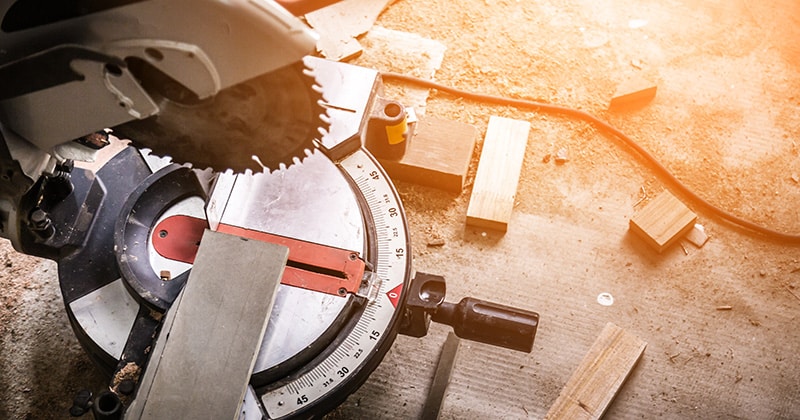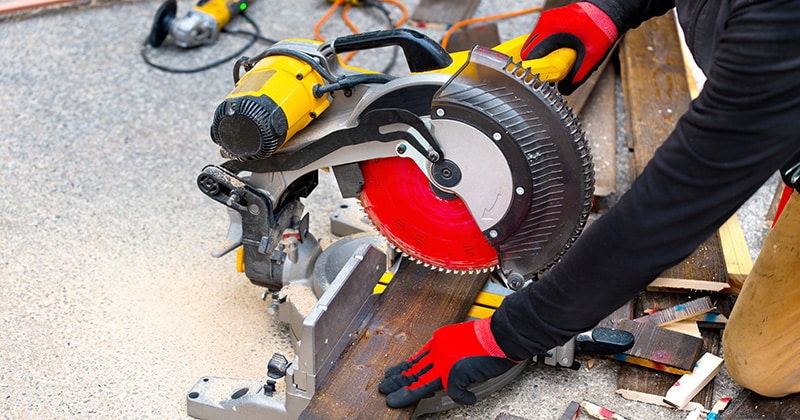The 6 Best Miter Saws for Professional Flooring Installation
They say a tradesperson is only as good as their tools. For flooring installers, choosing the best miter saw is key. Here’s a list of the six top models. Get ready to work faster and more accurately.

Staff Contributor
They say a tradesperson is only as good as their tools. For flooring installers, choosing the best miter saw is key.
Bad cuts can waste materials. They can upset your customers and delay your work, which might hurt your business.
Choosing a quality miter saw can fix these problems and make your job easier.
This article will show you why a good miter saw is important for professional flooring installations. We’ll talk about the key features to look for, the different types of miter saws that are best for flooring, and give you a list of the six top models.
We’ll also share some helpful tips to help you make a smart decision.
Get ready to work faster and more accurately.
Why You Need a High-Quality Miter Saw for Professional Flooring Installations
A miter saw is a tool that helps you cut materials like wood, metal, and plastic precisely. It works by pulling a round blade down onto the material that you hold against a fence.
When installing floors professionally, a high-quality miter saw is important—here’s why:
- Precision: This saw gives you exact cuts. You need these to make sure floor pieces fit perfectly and look exceptional.
- Efficiency: A good miter saw works fast. It helps you finish jobs quicker so you can do more work.
- Versatility: You can make many different cuts with the right miter saw. This is great for cutting floorboards the right size or making special shapes.
- Durability: Floor installation is hard work. A durable miter saw can handle a lot of use over time.
Key Features to Consider in a Miter Saw for Flooring Installation
What separates the average from the best miter saws? Here are some of the key features and considerations to think about when weighing your options.
Blade Size
The size of the blade determines how deep and wide your cuts can be.
Larger blades can handle wider materials. This is useful for cutting through thick floorboards or pieces of trim.
Common sizes are 10 and 12 inches. A larger blade means you can make bigger cuts in one go.
Motor Power
Motor power affects how well the saw can cut through materials.
A powerful motor will make it easier to cut through harder materials. The saw won’t struggle or stall. This helps you meet client deadlines.
As a general rule of thumb, look for motors with at least 15 amps of power.
Bevel Capacity
Bevel capacity defines the range of angle cuts you can make.
A saw with a dual bevel feature allows you to make bevel cuts in both directions without having to flip the workpiece.
This saves time and increases cutting accuracy. It’s a huge advantage for complex floor layouts.
Dust Collection System
When working indoors, a clean workplace is crucial. It keeps you and your team safe. And it keeps your clients happy.
A solid dust collection system helps manage sawdust. This keeps the area clean and your line of sight clear.
This not only improves safety but also helps with the precision of your cuts.
Portability
Most floorers move from site to site. For this reason, you’ll want your saw to offer some level of portability.
Look for a saw with carry handles or a stand with wheels.
Price
When running a business, every dollar counts.
If you’re in the market for a miter saw, you’ll quickly learn that prices vary a lot. Factors at play include size, power, and brand reputation.
As with most purchases, aim to balance cost with quality.
A more expensive model may offer greater durability and more advanced features. But it doesn’t mean it’s the best choice for you.
Mid-range priced models can provide excellent value and reliability for professional use.
Decide whether the higher price will really deliver a return on investment. Will you actually use those extra features? Or will a lower-cost saw get the job done just as well?
Types of Miter Saws Ideal for Flooring Installation
Before you hit the checkout button, you’ll need to decide which type of miter saw meets your needs.
Each has different benefits and drawbacks for professional floor installers. Let’s break it down.
Single Bevel Miter Saw
A single bevel miter saw can make bevel cuts in one direction. This means you can tilt the blade to one side to cut an angle on the edge of your material.
- Pros: Single bevel saws are generally lighter and less expensive. They are enough for most basic flooring tasks. This includes cutting trim. They also work when only simple angles are needed.
- Cons: For complex installations that need frequent opposite angle cuts, you’ll need to manually flip your workpiece. This can be time-consuming and may lead to errors.
Dual Bevel Miter Saw
This saw can make bevel cuts in both directions without needing to flip the workpiece.
- Pros: Dual bevel miter saws are ideal for complex flooring projects. They save a lot of time. Why? Because you can make matching bevel cuts on opposite sides of a workpiece without turning it. Easy.
- Cons: These saws are typically more expensive and heavier. This could be a drawback if price and portability are important to you.
Compound Miter Saw
The tool allows both miter and bevel cuts at the same time. That’s why it’s called a compound miter saw.
- Pros: Compound miter saws are versatile. You can make quick cuts at a combination of angles. This is great for more artistic or decorative flooring patterns.
- Cons: These saws can be more complex to set up and adjust. This might slow you down if you’re not familiar with the tool.
Sliding Compound Miter Saw
This saw combines the features of a compound miter saw with sliding arms. These let the blade move forward and backward. This design makes it possible to cut wider materials.
- Pros: Sliding compound miter saws are excellent for cutting wide floorboards or large pieces of trim. The sliding feature offers much greater cutting capacity.
- Cons: They are the most expensive type of miter saws. They are also the heaviest. This means they’re less portable and harder to maneuver around a job site.

How to Decide Which Type Is Right for You
When choosing a miter saw for your flooring installation projects, ask yourself these three questions:
- What types of materials do I usually cut? Consider the thickness and durability of the flooring materials you handle. Will you be cutting standard wood planks? Thicker materials? Or composite or delicate materials that demand extra precision?
- What kinds of cuts are most common in my projects? Think about the complexity of the installations you perform. Do you need to make basic straight cuts? Or do you often need to make compound cuts for intricate patterns and fitting?
- What is my budget, and how does it align with the saw’s features? Decide how much you are willing to invest. Is it more important to have a saw that offers versatility with different types of cuts? Or should you focus on a more basic model that fits a tighter budget but still delivers on quality and reliability?
The 6 Best Miter Saws for Professional Flooring Installation
Now, it’s time to reveal the best miter saws for professional flooring installation. When compiling our list, we focused on these criteria:
- Reliability and trust in a brand’s history of quality
- The saw’s ability to handle various materials and job sizes
- Accuracy of the cuts, which is crucial for professional finishing
- The tool’s ability to withstand heavy use over time
- The size of material the saw can handle
- Features that make the tool user-friendly
- Portability, which is important for professionals who work at multiple job sites during a single workday
With these considerations in mind, here are the six best miter saws.
1. Bosch GCM12SD Axial Glide 12-Inch Dual Bevel Glide Miter Saw
The Bosch GCM12SD Axial Glide miter saw is one of the best on the market—no questions asked. With an innovative glide system, it offers excellent cutting precision. Plus, its clever design maximizes workspace without compromising power.
Benefits:
- Axial glide system: Allows wider cross-cuts and better alignment while saving workspace
- Expanded cutting capacity: Handles up to 14 inches horizontally and 6.5 inches vertically
- Ease of use: Features upfront controls and a clear bevel scale for easy adjustments
Drawbacks:
- Weight: Heavier than other options, which may affect portability
- Price: Higher price point, but offers value for the cost
Here’s what one Amazon customer had to say:
“When I went through the manual and explored the saw’s features I could tell that the designers put a lot of thought into their product. Everything was well thought out, fluid, and easy to use.”
2. Milwaukee M18 FUEL 2734-20
Designed for high-demand environments, the Milwaukee M18 FUEL 2734-20 compound miter saw combines cordless convenience with powerful, precise cuts. It’s another top choice for professional floorers, carpenters, and remodelers.
Benefits:
- Power and efficiency: Delivers the performance of corded miter saws without the cord
- High-capacity battery: Offers up to 400 cuts per charge, so is capable of all-day use
- Shadow cut line LED light: Improves cutting precision with clear visibility of the cut line
Drawbacks:
- Battery not included: Requires separate purchase of M18 REDLITHIUM™ HIGH OUTPUT™ 8.0 battery pack
- Limited to smaller blades: Uses a 10-inch blade, which may not suit all cutting requirements
One customer left this review:
“Out of the box no adjustments were needed. Shadow line always appreciated. The cutting capacity of ~7 1/4” is more than adequate for 99% of my usual jobs (flooring, trim, etc).”
3. Festool 575306 Kapex Sliding Compound Miter Saw KS 120 REB
The Festool 575306 Kapex KS 120 REB miter saw stands out among the competition. With excellent precision and advanced dust extraction capabilities, it’s a sound option for professionals.
Benefits:
- Advanced precision: Features dual lasers that mark the exact cutting line and a micro-adjustable bevel angle with an upfront rotary knob for exact alignment
- Compact and efficient: Its rail-forward design further improves accuracy while leaving a compact footprint.
- Exceptional dust extraction: Offers up to 91% dust extraction efficiency, ensuring a cleaner work environment
Drawbacks:
- Price: It’s on the higher end of the price spectrum, but its precision and features could justify the cost.
Here’s what a buyer had to say about the price:
“This saw is expensive, but worth it if you are making furniture or other projects requiring accuracy.”
4. Bosch GCM18V-12GDCN PROFACTOR 18V 12-Inch Dual Bevel Glide Miter Saw
If portability is important to you, consider this saw. The Bosch GCM18V-12GDCN PROFACTOR offers mobility without sacrificing performance. It features a cordless design that doesn’t compromise on power or precision.
Benefits:
- Portability and power: Cordless design allows easy movement between job sites without sacrificing the capacity for heavy-duty cutting.
- Axial-glide system: Delivers wider cross-cuts, enhanced alignment, and a smoother glide while saving space
- Large cutting capacity: Handles a depth of 4.7 inches and a width of 15.7 inches, suitable for a variety of flooring materials
Drawbacks:
- Battery and charger not included: Additional purchase is needed for the battery and charger, contributing to the overall cost.
Here’s a customer review that offers some long-term perspective:
“Hands down, after 30 years of using a ‘chop’ saw from various brands, this is THE most accurate, easy, intuitive saw I have ever had the opportunity to use.”
5. DEWALT Sliding Compound Miter Saw 12-Inch (DWS779)
The DEWALT DWS779 sliding compound miter saw offers a robust design and laser-sharp precision. It’s another reliable choice for professional floorers.
Benefits:
- High precision and capacity: Features a stainless steel miter detent plate with 10 positive stops and a cam-lock miter handle that creates quick, accurate miter angles
- Powerful motor: Equipped with a 15 amp, 3800 RPM motor that handles tough cuts in large materials, including 2×14 lumber at 90 degrees
- Durable construction: Built with tall sliding fences that support 7-1/2-inch crown nested materials and linear ball bearings for smooth operation
Drawbacks:
- Size and weight: This saw is large and heavy, which might compromise portability.
- Power requirements: Being a powerful tool, it requires a stable power source, which may not be available in all field conditions.
According to one customer, these saws are long-lasting, even with heavy use:
“Good saw for the money. I’ve bought three of these 12” sliding dual compound miter saws over the years. They hold up to a lot of use and abuse.”
6. CRAFTSMAN V20 Single Bevel Cordless Sliding Miter Saw 7-1/4-Inch
The CRAFTSMAN V20 Cordless miter saw combines portability with sufficient power to handle typical job site cutting tasks. It’s smaller and less powerful than other models on this list. But, it may be good enough if you’re just starting out.
Benefits:
- Cordless convenience: Battery-powered design means excellent portability and ease of use without a power outlet.
- Compact and lightweight: Features a lightweight design with side carry handles, making it easy to transport and set up
- Efficient cutting: Offers a slide capability for up to 8-inch cross-cuts at 90 degrees and includes an LED cut line positioning system for enhanced accuracy
Drawbacks:
- Smaller blade and motor: The 7-1/4-inch blade and battery operation might not suffice for cuts requiring deeper or more aggressive power.
- Potentially short battery life: While it can make up to 585 cuts per charge, battery life may vary with heavier use, requiring frequent recharging or spare batteries.
Here’s a balanced review from a real-world user:
“This little saw is amazing! What it is not: a 15 amp 110v plug-in miter saw. What it is: the most handy miter saw I’ve ever used.”

5 Takeaway Tips for Selecting a Miter Saw
-
Assess your needs. Think about the types of cuts and materials you most often work with. This will help you decide whether you need a basic miter saw or something more advanced like a sliding or dual bevel model.
-
Choose the right type of saw. If your work involves wide materials or complex cuts, consider a sliding compound miter saw. For simpler tasks, a standard compound miter saw might suffice.
-
Set a budget. Decide how much you can afford to spend. Remember, investing in a higher-quality saw can lead to better performance and durability. This could save you money in the long run.
-
Consider brand experience. If you have had a good experience with a particular brand, it might be wise to stick with it.
-
Look for deals. Check for sales or discounts, especially during major holidays or when new models are released. This can make an expensive saw more affordable.
Beckie likes words! Whether she’s creating content or working on the shortest of short stories, she’s always thinking about craft. In her downtime, she contributes to her mission of filling up her camera roll with as many photos of her cats as possible. They hate it.

Business Solutions For Field Service Pros
EverPro offers specialized solutions designed for home and field service professionals. We’ve got the business tools to help you get the job done.



